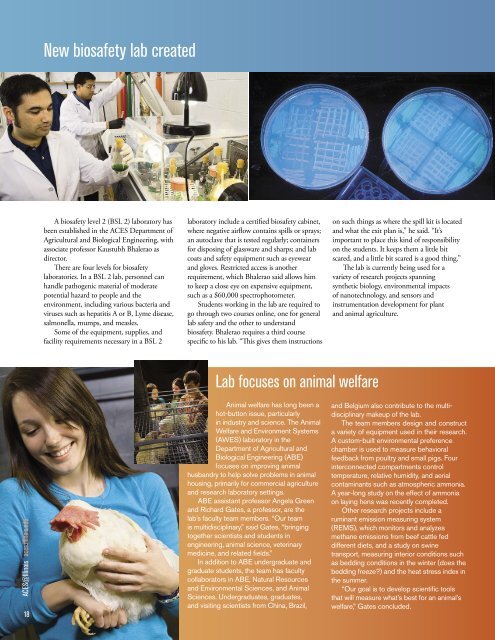t7W0J
t7W0J
t7W0J
You also want an ePaper? Increase the reach of your titles
YUMPU automatically turns print PDFs into web optimized ePapers that Google loves.
New biosafety lab createdA biosafety level 2 (BSL 2) laboratory hasbeen established in the ACES Department ofAgricultural and Biological Engineering, withassociate professor Kaustubh Bhalerao asdirector.There are four levels for biosafetylaboratories. In a BSL 2 lab, personnel canhandle pathogenic material of moderatepotential hazard to people and theenvironment, including various bacteria andviruses such as hepatitis A or B, Lyme disease,salmonella, mumps, and measles.Some of the equipment, supplies, andfacility requirements necessary in a BSL 2laboratory include a certified biosafety cabinet,where negative airflow contains spills or sprays;an autoclave that is tested regularly; containersfor disposing of glassware and sharps; and labcoats and safety equipment such as eyewearand gloves. Restricted access is anotherrequirement, which Bhalerao said allows himto keep a close eye on expensive equipment,such as a $60,000 spectrophotometer.Students working in the lab are required togo through two courses online, one for generallab safety and the other to understandbiosafety. Bhalerao requires a third coursespecific to his lab. “This gives them instructionson such things as where the spill kit is locatedand what the exit plan is,” he said. “It’simportant to place this kind of responsibilityon the students. It keeps them a little bitscared, and a little bit scared is a good thing.”The lab is currently being used for avariety of research projects spanningsynthetic biology, environmental impactsof nanotechnology, and sensors andinstrumentation development for plantand animal agriculture.Lab focuses on animal welfareACES@Illinois aces.illinois.edu18Animal welfare has long been ahot-button issue, particularlyin industry and science. The AnimalWelfare and Environment Systems(AWES) laboratory in theDepartment of Agricultural andBiological Engineering (ABE)focuses on improving animalhusbandry to help solve problems in animalhousing, primarily for commercial agricultureand research laboratory settings.ABE assistant professor Angela Greenand Richard Gates, a professor, are thelab’s faculty team members. “Our teamis multidisciplinary,” said Gates, “bringingtogether scientists and students inengineering, animal science, veterinarymedicine, and related fields.”In addition to ABE undergraduate andgraduate students, the team has facultycollaborators in ABE, Natural Resourcesand Environmental Sciences, and AnimalSciences. Undergraduates, graduates,and visiting scientists from China, Brazil,and Belgium also contribute to the multidisciplinarymakeup of the lab.The team members design and constructa variety of equipment used in their research.A custom-built environmental preferencechamber is used to measure behavioralfeedback from poultry and small pigs. Fourinterconnected compartments controltemperature, relative humidity, and aerialcontaminants such as atmospheric ammonia.A year-long study on the effect of ammoniaon laying hens was recently completed.Other research projects include aruminant emission measuring system(REMS), which monitors and analyzesmethane emissions from beef cattle feddifferent diets, and a study on swinetransport, measuring interior conditions suchas bedding conditions in the winter (does thebedding freeze?) and the heat stress index inthe summer.“Our goal is to develop scientific toolsthat will measure what’s best for an animal’swelfare,” Gates concluded.


